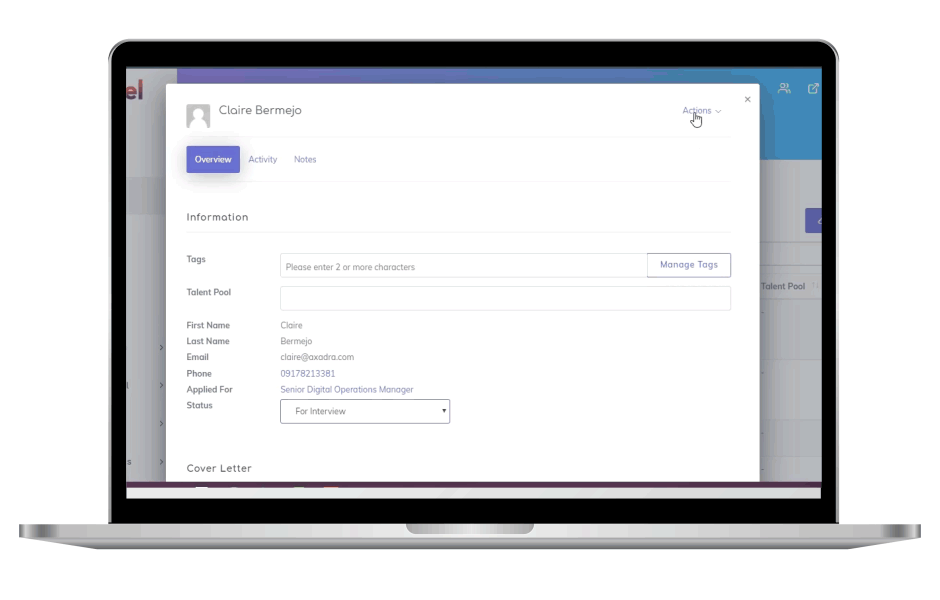With the influx of job applications and the ever-evolving demands of the workplace, recruiters and HR professionals are discovering the benefits of using an online applicant tracking system (ATS). Tasks such as writing effective job descriptions, poring over resumes, scheduling interviews, and monitoring candidates’ progress can now be automated.
But as with any tool or technology, ATS implementation comes with its own set of challenges. Fortunately, anticipating these challenges and knowing how to overcome them can help your organization be prepared. Skillfuel will walk you through common missteps and provide actionable tips to ensure that your ATS use goes as smoothly as possible.
An Overview of Applicant Tracking Systems
To better understand challenges in ATS implementation, let us first have a brief review of applicant tracking systems.
An applicant tracking system (ATS) is a software application or online platform designed to streamline the recruitment process for employers and recruiters. It serves as a centralized tool for managing job applications, tracking candidates’ progress, and automating various tasks that can be time-consuming yet essential.
By automating these tasks, ATS significantly reduces the time and effort required in recruitment. This allows recruiters to focus on more important activities, such as improving the overall candidate experience or employer branding. Many recruiters also report that using an online applicant tracking system has enhanced the quality of hire. ATS usually have features that enable recruiters to filter and rank candidates, which help ensure that only the most qualified applicants are considered.
ATS is also built to handle high-volume applications. This feature is especially useful for companies that frequently hire or have multiple open positions. Finally, ATS provides valuable insights that help HR professionals make informed decisions about their hiring strategies. With this data, recruiters can improve each stage of the hiring life cycle, which is crucial for attracting top talent.
Who Needs ATS?
Just about any organization can benefit from using an ATS to improve their recruitment process. If you’re wondering whether implementing an ATS is a good idea for your company, here’s a simple guide:
Growing Companies
Organizations experiencing rapid growth may find it challenging to manage hundreds of applications manually. If you want to keep up with the increasing amount of hires, use an ATS.
Small-to-Medium Enterprises (SMEs)
While it makes sense that larger corporations need ATS more, SMEs can also benefit from these systems. Many modern ATS solutions are designed to be affordable and scalable, catering to the needs of smaller HR teams that do not have the necessary resources to support their recruitment.
Companies with High Turnover Rates
Organizations with high employee turnover can use an ATS to expedite their hiring process and identify better-fit candidates.
Organizations with Complex Hiring Needs
Companies that require compliance with specific hiring regulations or have multiple roles to fill simultaneously can benefit from an ATS.
Even if you don’t fall under those categories, an ATS is still a worthwhile investment for your overall recruitment efforts. Here’s why.
Benefits of an Applicant Tracking System
- Improved Efficiency: ATS automates time-intensive tasks such as job posting, resume parsing, and candidate screening.
- Centralized Database: All candidate information is stored in a central location, making it easy to access and reducing the risk of data loss.
- Faster Time-to-Hire: Since everything is automated, you can screen, select, and hire candidates faster.
- Enhanced Candidate Experience: ATS can improve the candidate experience and attract top talent.
- Compliance: ATS can help organizations comply with employment laws and regulations by ensuring fair and unbiased hiring practices.
Challenges in ATS Implementation
Before you implement an ATS, there are challenges you need to watch out for. Here are some common pitfalls associated with adopting an online applicant tracking system.
Complicated Recruitment Workflow
For an ATS to be fully functional and effective, you need a defined recruitment workflow. Without one, your ATS will not live up to its potential. Organizations should take the time to map out their current recruitment processes and identify areas for improvement before introducing the system.
Unclear Objectives
Why do you need to implement an ATS in the first place? Failing to align stakeholders on the systems purpose and expected outcomes can become a challenge. Without specific, measurable goals, it can be impossible to evaluate the ATS’s effectiveness. Focus on identifying current recruitment pain points to clarify the need for an ATS.
Issues with Integration and Compatibility
Integrating an ATS with existing HR systems, such as payroll, employee databases, and recruitment websites, can be complex. If the integration is not well-coordinated, it can lead to delays, increased costs, and potential data inconsistencies. This challenge should be addressed during the selection process. Make sure that the ATS you’re choosing can easily be integrated into your current tech stack.
ATS Limitations
Not all ATSs are created equal. Limitations in ATS features can result in inefficient workflows, discourage user adoption, and ultimately, negatively impact your hiring process. It’s important to assess your company’s recruitment needs and choose an ATS that can support those—whether it’s candidate filtering, communication, or reporting.
User Adoption
Many ATS platforms have complex user interfaces and cumbersome functionalities. This may discourage your HR staff to adopt the technology. Some recruiters may also not understand the need for an ATS and prefer to do things the old-fashioned way. ATS implementation can only be successful if everyone on your team is onboard.
Insufficient Training
In connection with user adoption, the person who will handle the ATS needs to have extensive training before the actual implementation happens. So when choosing an ATS, consider ease of use and whether the service provider offers training.
Data Quality
The success of an ATS heavily relies on the quality of the data entered into the system. If existing data is not cleaned or standardized before implementation, it can lead to inaccuracies and inefficiencies. Prioritize data preparation to ensure high-quality inputs.
Resource Constraints
Implementing an ATS may require time and resources. Beyond initial purchase and subscription costs, ensure that you have the necessary budget and staffing to support both the implementation and the ongoing maintenance of the system.
ATS Implementation Checklist: Steps to Follow
Here’s a comprehensive checklist to guide companies through the process of implementing and using an online applicant tracking system:
1. Communicate the Changes
To get a buy-in from your stakeholders and team members, present how the ATS will address current bottlenecks in talent acquisition and recruitment. For example, if hiring managers may find reviewing applications too much of a hassle, point out how an ATS will make their life easier. On the other hand, if you already have an existing ATS and you’re trying to convince them to switch vendors, emphasize the downsides of the current system.
2. Quantify Your Goals
Clearly outline the reasons for implementing an ATS, including specific goals and expected outcomes. What do you hope to achieve in the next few days, weeks, and months? What are your KPIs and how will you measure your ROI? If your ATS implementation is intended to keep a central repository of applications no matter where they apply, then no candidate should fall through the cracks.
3. Assemble a Project Team
Depending on the ATS you choose, you may need to form a cross-functional team that includes representatives from HR, IT, and other relevant departments to oversee the implementation. This core team may also need to manage the ATS beyond its launch.
4. Plan the Implementation Strategy
Develop a detailed implementation plan that includes timelines, responsibilities, and milestones to keep the project on track. An implementation plan ensures that everyone involved in the project is held accountable for their roles.
5. Select an ATS
Research and assess different ATS vendors based on factors such as features, compatibility, support, and pricing. Keep in mind the challenges we’ve listed above, and consider how the vendor can assist you when those pitfalls arise.
6. Coordinate With the Vendor
The vendor knows their product best, so stay in touch with them while you execute your implementation plan. An ATSs ease of use means troubleshooting shouldn’t be too much of a pain. And if you’re following the vendor’s instructions and onboarding tips, everything should go smoothly.
7. Prepare Data for Migration
Clean and organize existing candidate data to ensure a smooth transition into the new ATS. This may involve removing duplicates and standardizing formats.
8. Integrate With Your Existing Workflows and Tech Stack
Ensure the ATS integrates seamlessly with other HR tools and systems, such as payroll and onboarding software, to maintain workflow continuity.
9. Train Staff
The ATS vendor should help your team master all the tools in their online applicant tracking system before completely handing it off to them.
10. Conduct Tests
Test the ATS with a small group of users to identify any issues or areas for improvement before the full rollout. You can also test features and recreate scenarios to check how the ATS works.
11. Launch the ATS
Officially deploy the ATS across the organization, ensuring that all users have access and support during the transition. While this part can be exciting and promising, make sure the ATS prioritizes simplifying the recruitment process for your employes and creating a positive candidate experience.
12. Collect Feedback
Continuously monitor the system’s performance and gather feedback from users to identify any challenges or areas for improvement.
13. Adjust as Needed
Use the feedback and performance metrics to make the necessary adjustments in optimizing the ATS.
Hire Faster and Easier with Skillfuel
An ATS is a software or online platform that enables recruiters to efficiently manage the many facets of hiring. By preparing for potential implementation challenges and following a checklist, your company can successfully harness the power of an ATS.
Ensure that you maximize the benefits of an ATS by partnering with a reliable vendor. Search no further than Skillfuel! We offer a user-friendly, multi-functional applicant tracking system (ATS) that helps HR teams eliminate bottlenecks in their recruitment process.
Sign up for a free version of our ATS today!















